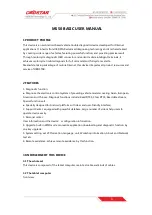
®
Model No. AP-8209
Photoelectric Effect Apparatus
4
Introduction
The photoelectric effect is the emission of electrons from the surface of a metal when
electromagnetic radiation (such as visible or ultraviolet light) of the right frequency shines on the
metal. At the time of its discovery, the classical wave model for light predicted that the energy of
the emitted electrons would increase as the intensity (brightness) of the light increased.
Instead it was discovered that the energy of the emitted electrons was directly proportional to the
frequency of the incident light, and that no electrons would be emitted if the light source was not
above a certain threshold frequency. Lower energy electrons were emitted when light with
relatively low frequency was incident on the metal, and higher energy electrons were emitted when
light with relatively high frequency was incident on the metal.
The AP-8209 Photoelectric Effect Apparatus consists of a mercury light source enclosure, a
photodiode tube enclosure, a base, the photoelectric effect test instrument, miscellaneous cords and
cables, a power supply for the mercury light source and the test instrument, and a box of apertures,
filters, caps, and alignment screws.
The apparatus has several important features:
• The current amplifier has high sensitivity and is very stable in order to improve the accuracy of the
measurement.
• The photoelectric tube has low levels of dark current and anode reverse current.
• The optical filters are of high quality in order to avoid an error due to interference between different
spectral lines.
Background Information
Many people contributed to the discovery and explanation of the photoelectric effect. In 1865
James Clerk Maxwell predicted the existence of electromagnetic waves and concluded that light
itself was just such a wave. Experimentalists attempted to generate and detect electromagnetic
radiation and the first clearly successful attempt was made in 1886 by Heinrich Hertz. In the midst
of his experimentation, he discovered that the spark produced by an electromagnetic receiver was
more vigorous if it was exposed to ultraviolet light. In 1888 Wilhelm Hallwachs demonstrated that
a negatively charged gold leaf electroscope would discharge more rapidly than normal if a clean
zinc disk connected to the electroscope was exposed to ultraviolet light. In 1899, J.J. Thomson
determined that the ultraviolet light caused electrons to be emitted from the metal.
In 1902, Phillip Lenard, an assistant to Heinrich Hertz, used a high intensity carbon arc light to
illuminate an emitter plate. Using a collector plate and a sensitive ammeter, he was able to measure
the small current produced when the emitter plate was exposed to light. In order to measure the
energy of the emitted electrons, Lenard charged the collector plate negatively so that the electrons
from the emitter plate would be repelled. He found that there was a minimum “stopping” potential
that kept all electrons from reaching the collector. He was surprised to discover that the “stopping”
potential,
V
, - and therefore the energy of the emitted electrons - did
not
depend on the intensity of
the light. He found that the maximum energy of the emitted electrons
did
depend on the color, or
frequency, of the light.





































